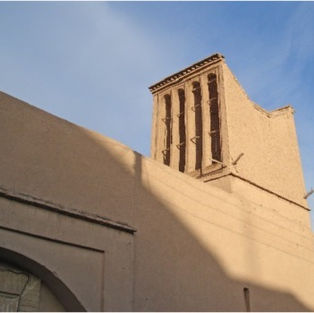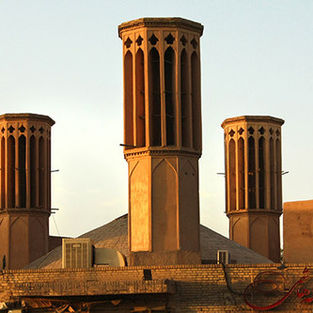The Takht Mahal in Bidar Fort has wind catchers also known as Badgirs, which help keep the interiors cool. Wind catchers are tall, chimney-like structures that protrude from the rooftop. They pull fresh air into buildings and allow hot air to ventilate out through large vertical slots. Cooler winds blowing at higher elevations are directed downwards through the narrow, vertical slits, subsequently pushing warm air inside the buildings up and out through an opening on the opposite side of the wind catcher. Even in the absence of a breeze, wind catchers work as solar chimneys, creating a pressure gradient that pushes warm air up and out through the tower, leaving the interior of the home feeling cooler than the exterior.
List of contents
1. Guidelines for incorporating windcatchers into buildings.

Windcatchers
1. Design of the windcatchers
Select windcatcher designs that complement the architectural style of the building. Click here to see types of windcatchers.
Use either Hexahedral windcatcher or square windcatcher for optimal effectiveness.
Note that, among all the options, Hexahedral windcatchers are considered the most effective. However, at a 0° wind angle, the square windcatcher is more effective.
The highest rate of ventilation is seen at a wind angle of 90°.
Height- The optimal height for windcatchers is 6-9 meters.
Cross section dimensions- The cross section of the windcatcher should be 1m2.
Inlet design- windcatcher with a divergent inlet has the best performance.
Blade configuration- the ventilation rate which was provided by plus form blade wind catcher was higher compared to other investigated geometries.
Climate considerations- In hot and arid regions such as Bidar, wind catchers that use evaporative cooling are more effective than ones that don't use evaporative cooling.
2. Orientation
The windward side of the Windcatchers should face northeast to effectively harness prevailing winds. (This is specific to Bidar University.)
3. Quantity
1. Determine the Room Volume:
- Measure the length, width, and height of the room.
- Calculate the volume by multiplying these dimensions (Volume = Length x Width x Height).
2. Determine the Air Change Rate (ACH):
- Decide on the desired air changes per hour for the room. This is often based on factors like room type, occupancy, and comfort requirements.
3. Calculate Required Airflow:
- Multiply the room volume by the desired ACH to find the required airflow per hour.
4. Convert Airflow to Cubic Feet per Minute (CFM):
- Divide the required airflow per hour by 60 (minutes) to get the required CFM.
5. Determine Windcatcher Airflow Capacity:
- Consult the specifications of the chosen windcatcher model to find its airflow capacity in CFM.
6. Calculate Number of Windcatchers:
- Divide the required CFM by the airflow capacity of one windcatcher to determine the number needed.
Remember that these are general steps, and the calculations might involve additional factors.
4. Building Orientation:
Orient the building to capture prevailing winds and direct them toward the Windcatchers.
.




X blade
Elevation
H blade
Plus blade
K blade
Plan
Elevation
Plan
Elevation
Plan
Elevation
Plan
Guidelines.
Types of windcatchers.
How do windcatchers work?
Wind towers are generally used in hot and dry climates for cooling purposes. The tower's purpose is to catch the wind at higher altitudes and direct it into the living space.
The fundamental idea behind its operation lies in changing the temperature and thereby the density of the air in the tower.
The difference in density creates a draft, pulling air either upwards or downwards through the tower. For example, when air becomes warm, its density decreases, and it moves up. This creates a vacuum and pulls in cool air through the doors and windows.
How they work at night.
In the absence of wind, the tower acts as a chimney.
The tower is designed in such a way that the top portion can store a lot of heat and also has a large surface area for heat transfer. The internal walls of the tower absorb heat during the day and release it at night, warming the cool night air in the tower. Warm air has low density, so it moves up creating an upward draft, and escapes through the openings. This creates a vacuum and pulls the cool night air through the doors and windows into the building.

In the presence of wind, the cool night air enters the tower and forces itself down into the structure. when air flows through the tower, the velocity increases, and the pressure decreases (Bernoulli's and Venturi's effect). And according to the laws of thermodynamics, the temperature decreases.
How they work during the day
In the presence of wind
The wind enters the tower through the openings. when the wind comes in contact with the cool upper part of the tower it gets cooled. It becomes cold and dense and sinks through the tower and into the living spaces, replacing the hot air. In the presence of wind, the air is cooled more effectively and flows faster down the tower and into the living area.
In the absence of wind
The temperature of the tower soon becomes warmer and hence, in the absence of wind, the downward flow ceases, the tower then begins to act like a chimney.





